2. This rewritten Modern Love column is hilarious. To appreciate it you probably want to read the original first. Related data analysis.
3. Why don’t we see wine self-experimentation?
4. The Mum Effect.
Thanks to Joyce Cohen.
2. This rewritten Modern Love column is hilarious. To appreciate it you probably want to read the original first. Related data analysis.
3. Why don’t we see wine self-experimentation?
4. The Mum Effect.
Thanks to Joyce Cohen.
My observations:
1. The first task I used to measure my mental function at frequent intervals (e.g., every 30 minutes) resembled an typical cognitive psych task. It wasn’t fun and I had to push myself to do it.
2. I made another test to do the same thing based on the lessons I drew from bilboquet. It consisted of tracking circles around the screen. It was mildly fun.
3. Trying to improve the second test, I made a third test, which consisted of “tossing” the cursor from one point to another — like throwing darts. In spite of its simplicity, it was/is a lot of fun. Slightly addictive.
My theory of human evolution places great emphasis on hobbies (which at first were varieties of tool making) and job specialization. Hobbies must be fun. So that we will do them — or at least so our Stone Age ancestors would do them — they must provide pleasure. Where does this pleasure come from? The third task suggests a source: We enjoy simple hand-eye tasks with feedback where there is plenty of room for improvement. The Stone-Age hobbyist is trying to get this or that stone or piece of wood to do what he wants. The importance of job specialization — people must be able to enjoy a wide range of jobs, and the first jobs derived from hobbies — implies that the pleasure derived from hobbies must be “free-floating.” It cannot be closely tied to any particular hobby; to encourage a wide range of hobbies (= a wide range of tools) it must be generated by a wide range of hobbies. Because it is free-floating, we should be able to generate it from something quite different from a Stone-Age hobby, such as my third test. The Stone-Age hobbies we’re talking about, ur-technology, involved making things — which involves hand-eye coordination. The third test was more fun than the first two because it was closer to a Stone-Age hobby.
I don’t yet know if the third test is sensitive to flaxseed oil. I have doubts because it seems to involved only a small amount of mental computation per minute of testing. I believe flaxseed oil improves all brain function, but this test may require too much time (e.g., 20 minutes per session) to see the effect clearly. The other tests show the effect and take about 3 minutes per test. One reason balance clearly showed an effect of flaxseed oil is, I think, that it is computationally very intensive. A huge amount of computation goes on at once. A kind of averaging goes on, making systematic differences larger relative to noise.
Nathan Yau, a graduate student in statistics at UCLA, has started a self-experiment about procrastination. He is measuring his procrastination by how much he surfs the web. To reduce it, he is doing two things: 1. Make to-do lists. 2. Block favorite sites. More info here. He’s starting today or tomorrow.
Drug addiction, sure. The first pleasurable drugs were probably discovered hundreds of thousands of years ago, if not much earlier. All cultures use drugs. Drugs physically reach the brain. But video game addiction? Video games are a millisecond old, compared to drugs. How did they get so potent so fast?
Self-experimentation made me ask. Using an ordinary psychological test and a speeded arithmetic task, I discovered a fast-acting effect of flaxseed oil. About two hours after ingestion of 4 tablespoons, my brain worked detectably better. The effect wore off over several hours. To properly study this effect, and exploit it to learn more about what fats we should eat (which has been very hard to figure out), I would have to test myself many times per day for many days. Thousands of tests. It would be a lot easier if the tests were fast, portable, and fun — especially fun. Many computer games have these traits. But they don’t provide the data I need, which is a measure of how well my brain is working, and they take too long.
After talking with Greg Niemeyer, I came up with four properties, shared by many games, that might be why they are fun: 1. Right difficulty level. Neither too easy nor too hard. This is a variable emphasized by Mihaly Csikszentmihalyi in Flow. 2. Feedback. You learn how well you are doing. 3. Variety. Not the same thing over and over. 4. Color. I constructed a task with all four features. To my dismay, it wasn’t fun! (So much for the placebo effect.) I had to force myself to do it.
I had no idea what was wrong. Then, as I’ve written, a friend gave me a bilboquet, which led me to think that there were two principles of fun-making I’d left out: 1. Hand-eye coordination. We enjoy tasks that involve this. 2. Completion. We enjoy tasks where something is cleared up or put neatly together.
I used these ideas to construct a new test. It consisted of moving the cursor around the screen from one colored circle to the next. I move the cursor to a circle and click on it. That circle disappears and a new circle appears somewhere else. It’s a bit like shooting one circle after another. Aim, click, aim, click. Each circle is effectively a new trial. The speed at which I moved the cursor to the new circle and click on it is the main measure. There is trial-by-trial feedback: the color of the next circle depends on how quickly I got to the last circle. Here’s a screen shot (cursor not shown):
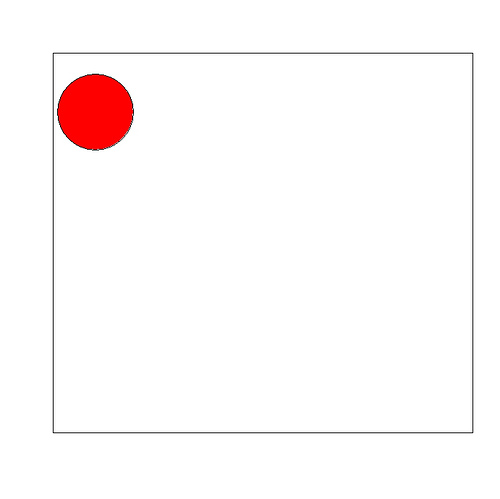
I did this on a Thinkpad. I used the trackpoint to move the cursor. This had the pleasant feature that there was no obvious learning curve — I didn’t improve with practice. Presumably because I have years of practice with the trackpoint
Eventually I got around to the big question: Was this test sensitive to the effects of flaxseed oil? I’ve done two series of measurements to answer this. Here are the results from the first series:
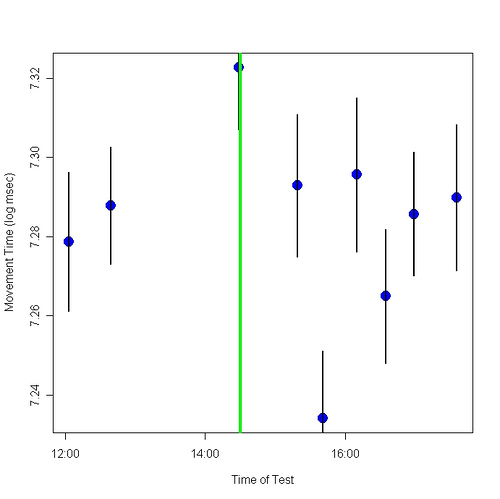
The green line shows when I drank 4 tablespoons of flaxseed oil (without lignans). Here are the results from the second series:
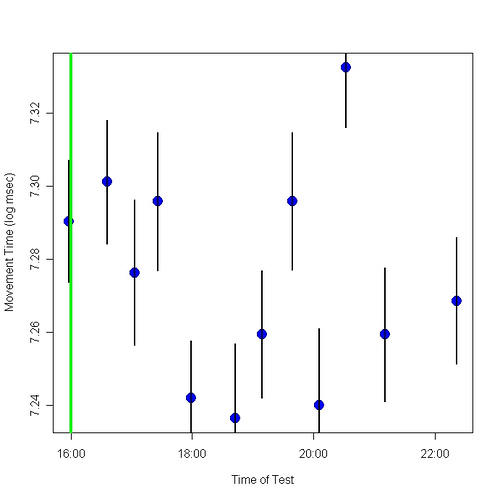
Again, the green line shows when I drank 4 tablespoons of flaxseed oil.
Both times the results resembled my previous results. The flaxseed oil appeared to cause a decrease (= improvement), which reached a maximum around 2 hours after ingestion and declined. The results were far from beautiful but because of the similarity to earlier results (here, here, and here) I found them fairly persuasive. They certainly suggest doing more with this test.
Then I made a different game…
After I saw that flaxseed oil probably affected my circle-game performance, I wondered how to make its effect clearer. One possibility was to change the input device. I was using the trackpoint on my Thinkpad to move the cursor; what about the touchpad? Might be a more natural task. So I played the game several times using the touchpad. I was a lot slower, presumably because in ordinary usage I’ve used the trackpoint.
I wondered: Could I get better on the touchpad? I made a little game to practice. Here is the initial screen.
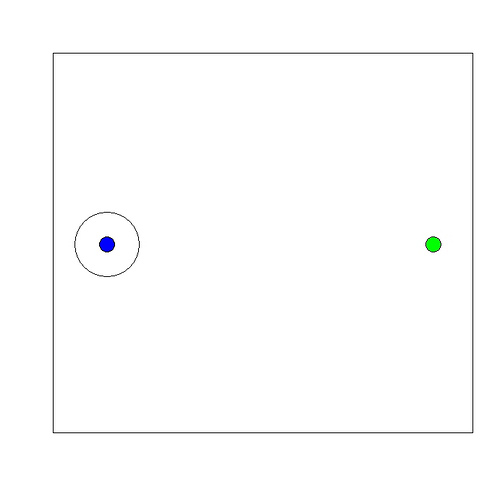
You begin by moving the cursor to the green circle. Then with one movement — one fingerstroke — you move the cursor as close as possible to the blue circle. You “toss” it at the blue circle. You click where it ends up. It’s a lot like free-throw shooting and darts. You do that again and again; at the moment each test session consists of 35 “tosses”.
The outer circle around the blue circle is based on the previous 200 trials; the radius of that circle is the median distance. If I’m improving, I’ll be within the outer circle more than half the time.
Here are sample results (from the most recent session).
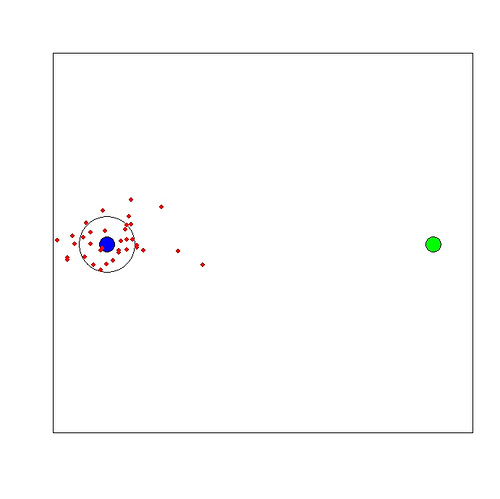
Here is my learning curve. The y axis is the average distance from where the cursor landed to the middle of the blue circle. The bars show standard errors.

I have collected a lot of data in my life. This particular dataset (data from about 1700 trials) was the easiest. To my great surprise, this exceedingly simple game is great fun! I have to push myself to not do it.
What makes games addictive? This game has 1. Hand-eye coordination. 2. Feedback. 3. Difficulty. It doesn’t have 1. Variety. 2. Action.
Part 1. Part 3: Interpreting the results.
Addendum. A poem called “ Needle’s Eye” in this week’s New Yorker ends like this:
what does it matter how big
a target you are? Someone somewhere
will invent a game to make you hard to hit.
This sounds promising. I have read more words written by Vladimir Nabokov than by anyone else, by a large margin. A few days ago I was watching American Idol and thinking about how I have come to enjoy singing more because of the judges’ evaluations. It reminded me of reading Nabokov’s commentary to Eugene Onegin when I was in college. In his commentary, Nabokov passed judgment on many lines of poetry — “this is beautiful,” “that is awful.” Studying those remarks — what did he see? — made me read in a new way forever.
Any idea? Here is a helpful comment by SixtiesLibber on the SLD forums:
When you get your fasting blood sugar tested, it’s supposed to be below 100. And it should almost never go above 200. Well, I finally checked and found what what those numbers mean, that’s 100 milligrams per deciliter. That’s kind of a weird measurement but it’s actually the same as 1000 milligrams per liter or 1 gram per liter. In other words, normally your blood has only 1 gram of glucose (sugar) per liter. (A liter is almost the same as a quart.) Adults have something like 5 quarts of blood in their bodies. So at any one time you only have about 5 grams of glucose circulating in your blood. That’s the equivalent of about 1 teaspoon of sugar or one-third of a piece of “squishy white bread.”
Answer: Not many.
In the first experiment, I created a butter mixture with a random flavor and spread it on two pieces of bread, which I ate and rated.
To create the butter mixture with a random flavor, I took 1/2 stick of butter and heated it in a microwave until it was soft. Then I randomly selected four of the 11 Penzeys spice blends and mixed 1/2 tsp of each into the butter.
For each trial, I spread a thin layer of the butter on two pieces of the bread, which was at room temperature. I ate them in a minute or so. I rated how good they tasted on a scale where
90 = very good
80 = quite good
75 = good
70 = somewhat good
60 = slightly good
50 = neutral
40 = slightly bad
I’ve used this scale to rate food dozens of times. Sometimes the rating changes with successive tastes; if so, the assigned rating is the maximum.
After eating the bread I waited at least an hour before eating anything else or brushing my teeth in order to to eliminate interference from other smells.
I did no more than one trial per day. On most days I did a trial.
To find other posts in this series, use the Calorie Learning category.
Over at the SLD forums, Heidi555 posted these useful links:
1. Nose clipping ditto foods to extinguish cravings
2. Conditioning Appetite Suppression
3. Nose clipping lots of food really works — it’s easier!
This is about as far from the “losing weight is just a matter of calories in versus calories out” dogma as you can get. Last week at a dinner I sat next to a young doctor who said exactly that. I said nothing.
Thanks, Heidi.
Anonymous writes again:
I got caught in a nasty achilles lock the other day–it’s an MMA [mixed martial art] submission move–and while trying to escape, I accidentally dislocated my fibula at the knee. It made a LOUD popping noise, to the point where everyone in the gym stopped. It popped it back in immediately, and other than some instability, it felt OK. Thankfully there was a doctor there (by chance–he does MMA and was in my class). He spent like 15 minutes examining my knee and said that other than some stretched ligaments, it was fine. His quote (I’m paraphrasing):
“That’s amazing. You should need reconstructive surgery right now. I don’t know how that happened, you must have rubber ligaments.”
I told him about taking 4 tablespoons of flax seed oil every day, and he was shocked, and said he was going to research it to see if that could be why I got so lucky. Told him to Google you, it’s all there.
The injury happened Friday. Today (Tuesday) the doctor looked at my knee again in class, and he was amazed not only at the lack of swelling, but that I was able to roll today (not full speed, just lightly).
I have played sports my whole life and have had at least half a dozen various knee injuries. Things like minor cartilage tears, hyperextensions, strains, etc.–none that were this major (a dislocation of a bone at the joint). Of those injuries, I was out longer and recovered much slower than I have with this one. I know this isn’t proof of anything, and I don’t know how much the flaxseed oil has had to do with what happened, but even the doctor is shocked.
More about omega-3 and sports injuries here and here and here.
Addendum. He uses Whole Foods flaxseed oil without lignans.